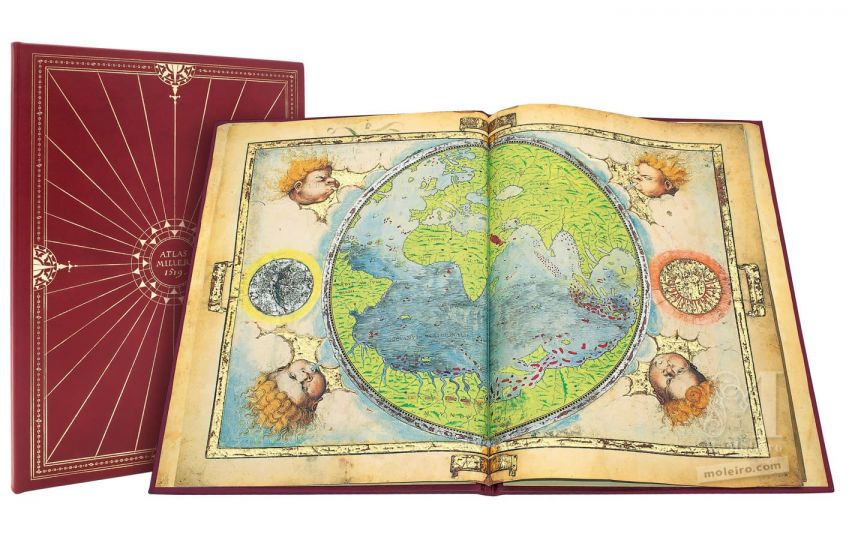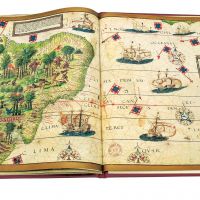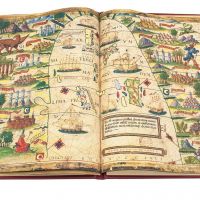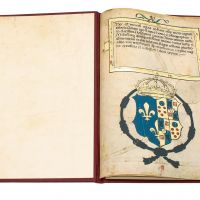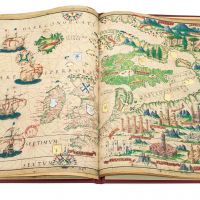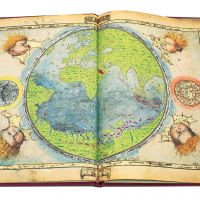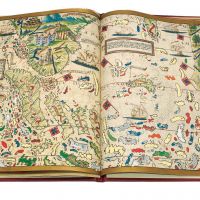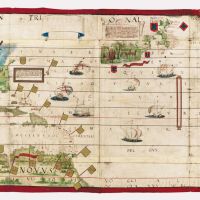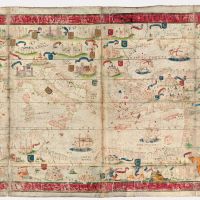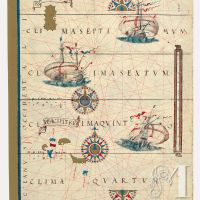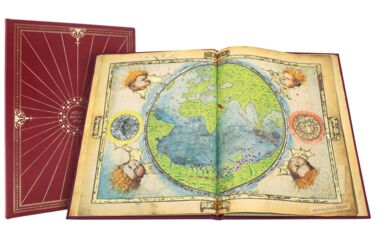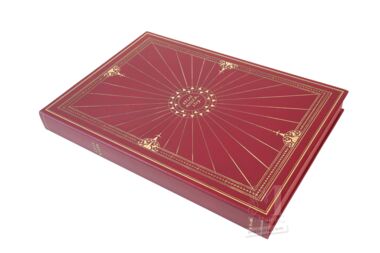PREFACE
Who better than the team comprising Alfredo Pinheiro Marques and Luís Filipe Thomaz to write the study which accompanies this superb facsimile edition of the so-called Atlas Miller’
The Atlas Miller has aroused the interest of successive generations of researchers working in a broad range of academic fields, including history in general and its various specialist areas, geography, the European expansion, politics, art, cartography and even science. All these fields have consistently tried to present the Atlas Miller as an exceptional means to gain a better understanding of the age when the work was created.
The first and most obvious reason why the Atlas Miller has gained pride of place among the various sources that have survived from the century of marvels is that it is a truly outstanding work of art. Those who gaze at the magnificent pages of this edition will immediately understand the fascination that the atlas has held for so many people over time. Even if one could do nothing more than simply look at its pages, the Atlas Miller would still be one of the highpoints of the culture that produced it.
Yet the interest of this atlas goes far beyond its enormous face value. There is a second reason, perhaps the most profound, for its perennial attraction: the atlas raises a vast range of questions that are themselves challenges to our understanding of the dynamic world in which it was created. Perhaps, despite its apparent aim of disclosure, the Atlas Miller hides more than it reveals… Discovering what it hides and why it does so will lead to twice the knowledge. In those terms, it can be truly claimed that the atlas has brought another – invaluable and involuntary – record of its age down with it over the centuries, one that has been widely misunderstood until today.
The challenge of deciphering the Atlas Miller, which has been previously accepted (with little success) by other authors, has now – for the first time – been met in the chapters written by Alfredo Pinheiro Marques. The story he tells is new, enthralling from the very start to the last page, and raises fundamental questions that were previously unknown. More importantly, his sure handling of the subject brings new clarity to interpreting the circumstances surrounding this exceptional work and the motives behind its creation. It is as if the most hidden secrets of the atlas, which already has its shades of sepia, gilding and crimson, have been painted with an invisible ink that is only now taking effect before our startled gaze.
I have always enjoyed Alfredo Pinheiro Marques’ historical works, and have been an ever-interested reader. His encyclopaedic knowledge of various fields is compounded by the factual accuracy that is a feature of his work. That is normally how things work: those who truly know are demanding, those who know less often have to use their imagination. He understands history the same way I do: theories have to be put forward, even if only based on intuition or firm individual conviction, but they can never be established as conclusions until such time as they have been proved. Moreover, no analysis can ignore, cover over or distort documented facts that may damage or invalidate such theories.
Alfredo Pinheiro Marques’ works have always introduced me to new facts that he has systematically discovered, and I have always been free to agree or not with the conclusions he draws from such information. A true historian never settles for writing what has already been written, but always goes further, so that each work published is an advance and creates a new point of departure. There are few such historians left.
Alfredo Pinheiro Marques is again bringing new information to light here. He has already published one highly innovative study on the person responsible for the artwork in the Atlas Miller, a work whose conclusions he now confirms through additional arguments. His new interpretations on other aspects of the atlas are again pioneering. Given the known facts and the new information that he presents, the well-grounded conclusions that Pinheiro Marques reaches are probably as accurate as can be achieved when reconstructing a distant past and bringing the multiple strands together to form an integrated vision.
Luís Filipe Thomaz sees the work from a different but equally original point of view. He proposes an interpretation whereby the Atlas Miller is an ideological manifesto that reflects the imperial ambitions of King Manuel I, who was obsessed with constructing Mankind’s first truly intercontinental or global empire.
Luís Filipe Thomaz’ immense learning helps us to gain a better understanding of the ideological context surrounding the atlas and to penetrate the multiple facets involved in constructing the monarch’s concept of almost messianic predestination.
Of course, Luís Filipe Thomaz is another essential reference in contemporary Portuguese historiography. His enormous knowledge of all areas related to the Portuguese expansion is expressed through seminal studies in areas where few dare to tread and where his rare understanding enables him to achieve significant triumphs. He is rightly considered to be the leading Portuguese Orientalist. I have always been an avid reader of his work and much of what I have learned from him could probably not have been learned from anyone else. The academic rigor and the clarity of his chapters will delight readers, for these are qualities that – for our shared benefit – are a constant in his work.
The chapter on a direct reading of the Atlas Miller, in which the authors are joined by Bernardo Sá Nogueira, completes a study that is, in all aspects, an exemplary work. It is unusual for such a high quality study to be published as company for a monumental work of this nature, especially in the field of cartography. Normally, this type of work requires little more than a critical review of other authors’ work or comments on the current state of research in the subject. Yet Alfredo Pinheiro Marques and Luís Filipe Thomaz had trodden a different path.
Characteristically, the former has used this study as a pretext to produce a noteworthy piece of research (as readers will discover), while the latter has written a no less important article on the history of thought in an area where such studies are sadly few and far between. As a result, this book goes far beyond the expectations that could reasonably be drawn from its original purpose.
Indeed, that is another of the merits – and certainly not the least of them – of this magnificent M. Moleiro edition of the Atlas Miller. The decision to publish this work has created the opportunity for significant advances to be made in historical research. In addition to the great virtue of making a unique and previously almost inaccessible work of art available to all those interested, this edition will be a seminal work in historiography. If the Atlas Miller was already a milestone before this edition, it will be another, very different and much clearer one from now onwards.
I am convinced that readers who love history – as I do – will love what they are about to read.
Eng. Joaquim Ferreira do Amaral,
Historiador da Cartografia
GEOPOLITICAL COUNTERINFORMATION FOR THE EYES OF A PRINCE (OR PRINCESS): MILLER ATLAS AND THE AGE DISCOVERIES (1519)
The dying days of the Middle Ages and the dawn of the Renaissance brought with them the greatest geographical revolution in the history of Mankind. The late fifteenth and early sixteenth century were the age of King João II, Portugal’s “Perfect Prince” and of his successor King Manuel I. These were also the years of King Ferdinand and Queen Isabella (the Catholic monarchs), an era that was to continue with the reign of Emperor Charles V, his heir. It was in this period – during the forty years between the Portuguese voyages of 1480-1485 by the Luso-Galician Diogo Cao (to Africa, beyond Guinea) and the Castilian voyage in 1519-1522 by the Portuguese Ferdinand Magellan (to the Pacific and around the globe) – that the major expeditions took place: Bartolomeu Dias 1487-1488 (Cape of Good Hope); Christopher Columbus 1492-1493 (the unknown lands of the West subsequently baptised America); Paulo and Vasco da Gama 1497-1499 (Indian Ocean and India); Amerigo Vespucci in 1499-1501 (the New World, which he reconnoitred with men from Castile and Portugal, which is why these lands were named after him), etc. Hence from João II to Charles V, in the life of a single generation between 1480 and 1520, the essence of the great, mutual geographic discoveries and great intercontinental encounters between civilisations happened. Cartography – the “science of princes” – reflected this extraordinary explosion of geographical and anthropological knowledge, exotically illustrated with luxurious and exuberant artistic illuminations. The most outstanding outcome of this renovation of the “Image of the World”, in which art and science joined forces, is evident in the Portuguese atlas now housed in the Bibliothèque nationale de France in Paris, known as the Atlas Miller (c. 1519-1522), by the cartographers Lopo Homem, Pedro Reinel and Jorge Reinel and the miniaturist António de Holanda. This veritable masterpiece with its geographic innovations and sumptuous artwork portrays the forty years that changed the world on the eve of Ferdinand Magellan’s circumnavigation of the globe. This is why it was always deemed to be the most important atlas of world cartography from the time of the great geographical discoveries and is the pride and joy of the Département des Cartes et Plans in the Bibiothèque nationale de France. The studies in the commentary volume of this identical reproduction by M. Moleiro Editor offer remarkably fresh insights, shedding new light and changing forever not only the knowledge to date of this masterpiece of cartography and Renaissance art but also, in more general terms, what was known until now about the origins and early days of the cartography of the Portuguese discoveries (15th and 16th centuries). This cartography is studied here with an in-depth analysis of its first known “school”, the school constituted by Pedro Reinel and his son Jorge Reinel, reaching the conclusion that these two men – the first cartographers to chart the geographic discoveries of the West and the European colonial expansion – were Portuguese of African origin and therefore referred to as black by their contemporaries.
As regards the exceptional geographic meaning of this atlas, what was always considered to be the “mystery” of this famous work of cartography is now revealed. According to the theory put forward here, the Atlas Miller is an instrument of geographic and geopolitical counterinformation. It is the graphic expression of the Portuguese strategic vision of the globe intended to counter the vision upheld by Castile, for the peculiar “neo-Ptolemaic” concept it features, with the sea as stagnon (the oceans surrounded by land, the New World as a continent, the mythical Austral Land, etc), suited the Portuguese in c. 1519 because it suggested that it was not possible to sail westwards across to the other side of the planet, i.e. to do what was attempted first by Columbus and subsequently achieved by Ferdinand Magellan…). This is why the Portuguese ostentatiously, splendidly and officially accepted and disseminated this concept. The “secret” of the Atlas Miller is that it attempts to contradict the idea that the circumnavigation of the globe is possible.It tries to thwart the project being prepared at exactly the same time by Ferdinand Magellan. This atlas was made “to be contemplated by certain Luso-Castilian, courtly circles particularly susceptible to circulating information intended for Castilian courtly circles”. Hence the cartography historians who were surprised by the blunders in the “incorrect” mappa mundi in the Atlas Miller some time ago, were right. In some respects, this mappa mundi is indeed “incorrect” (despite being true…). However, the historians who declared that it was correct and contemporary, and that it had originally formed part of a single codex along with regional charts, and that it was made by the same people involved in producing and decorating those regional portolan charts were also right. The mappa mundi in the Atlas Miller is “incorrect” because it was made this way deliberately, in the same period by the real authors. It is a geopolitical fake depicting the Portuguese strategy of 1519 designed to counter the Castilian strategy.
The Atlas Miller is an unusually splendid work, for its pages, decorated by a Flemish miniaturist and brimming with Flemish style illustrations, were commissioned by old D. Manuel, the “Pepper King”, for the type of person for whom Flemish books of hours were usually intended in that period: a Flemish princess… And the Flemish princess in question was the sister of Emperor Charles V, Leonor, the princess who was once betrothed to the crown prince of Portugal (the future João III), but who married D. Manuel in the end after he stole his son’s fiancée. Their marriage lasted almost three years until he widowed her in 1521. The very fact that the Atlas Miller was left unfinished, between 1519 and c. 1522, with pages twenty and twenty-one incomplete, confirms that D. Manuel “the Fortunate” did not send it abroad as a gift of state for a European dignitary such as the king of France.
This work, begun in 1519, was intended quite simply for Leonor, his young wife and the sister of the sovereign of neighbouring Castile, Emperor Charles V, in whose service Ferdinand Magellan had been working since 1518 – the badly-treated, Portuguese exile preparing to sail around the world in the service of the Castilians… those appreciated neighbours, rival brothers and cordial competitors.
This time, cartography, or the “science of princes”, was intended for a princess. “Cherchez la femme” as the French say. The reason was not merely fondness of the arts or love itself. It is now also revealed that this atlas, so strange and lavish and intended for the eyes of Emperor Charles V and the men of Castile, was in fact an instrument of geostrategic, geopolitical and diplomatic counterinformation that even featured nautical mystification…
The Atlas Miller is the last Portuguese attempt to thwart Columbus’s plan. This atlas was created to counter the voyage by Ferdinand Magellan, and the voyage by Ferdinand Magellan was done to counter the Atlas MillerAnd what is remarkably surprising – really amazing – is the fact that for several months in 1519, travelling to and fro across the frontier, the same cartographers took part in both projects, producing the Atlas Miller in Lisbon and preparing the voyage by Magellan in Seville: Pedro Reinel and his son Jorge Reinel! When analysed from a scientific and critical viewpoint, the truth really is stranger than fiction.
These two men, Pedro and Jorge Reinel, were the two finest cartographers of their times. It was on the basis of their knowledge that the first circumnavigation of the globe was prepared for the Crown of Castile. It was also more or less at the same time, in that extraordinary year of 1519, that the Atlas Miller, which can be said to be the most important atlas in the history of the cartography of the European geographic discoveries, was produced for the Crown of Portugal, also on the basis of their knowledge. A work of this nature, combining the most advanced science then possible and the finest art then available with curiosity, beauty and rigorous and exotic portrayals of the new lands outside Europe, could only be produced at that time in Portugal: the country then offering the incredible and extraordinary circumstances of three men surprisingly working together on a fascinating masterpiece: a black cartographer, an Iberian nobleman and a Flemish painter…Pedro Reinel, Lopo Homem and António de Holanda… Extraordinary circumstances. An extraordinary work.
Alfredo Pinheiro Marques
Director of the Centro de Estudos do Mar Luís de Albuquerque
The Atlas Miller, made in 1519 by Lopo Homem, Pedro Reinel and his son Jorge Reinel with miniatures by António de Holanda, is one of the wonders of sixteenth-century Portuguese cartography. It reflects a concept of geography identical to the one employed by the staunch supporter of Manueline imperialism, Duarte Pacheco Pereira, in his Esmeraldo de Situ Orbis: a globe showing a fourth continent at the end in addition to the three known to the Ancients, and in which land predominates over water and the sea is shown merely like a large lake surrounded by land. From an aesthetic viewpoint, the atlas is peerless. It is undoubtedly the most lavish work of its genre, which suggests that King Manuel commissioned it as a state gift, although it is not known for whom. It can even, to a certain extent, be deemed to be propaganda for Manueline imperialism, tinged with messianic airs.
The cartographers masterfully combined information from the Portuguese discoveries with details taken from Ptolemy to plot a world that had apparently already been completely discovered – a sign that the end of time was nigh, the moment when no century-old secret would remain hidden. The miniatures exude a feeling of optimism for the exotic elements they depict – elephants, camels, American fauna, Brazilwood, the powerful cities of Asia – become familiar and wealth abounds, heaping possessions upon the needy and uplifting the humble. All this is, of course, thanks to the efforts of one of the Lord’s Chosen Ones, who chooses the weak to confound the powerful...
Prof. Luís Filipe F. R. Thomaz,
Director of the Institute of Oriental Studies of the Universidad Católica Portuguesa
